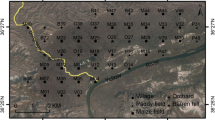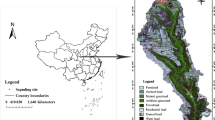Abstract
In order to determine the characteristics of heavy metals’ pollution and identify their sources in the soil over the Xiaoqinling gold-mining region, Shaanxi, China, 133 soil samples were collected over the region, one sample was from a close point as background, and concentrations of Hg, Pb, Cu, and As in all samples were analyzed. Results indicated that the soil was polluted by these heavy metals, as their concentrations in the soil over the studied region were higher than that in the background zone. In addition, the result indicated that these metals had their specific spatial characteristics. Among the samples, those with higher concentrations of Hg, Pb, and Cu were mainly collected from the Shuangqiao river alluvial terrace area, the loess ravine tableland, and the piedmont alluvial–pluvial inclined tableland, which are the areas of gold-mining activities. Meanwhile, the samples with higher concentrations of As were distributed over the loess ravine tableland around Tongguan County, where agricultural activities were conducted intensively. Furthermore, the sources for all the heavy metals Hg, Pb, Cu, and As in the soil over each landscape were determined through analyzing the concentration correlation of these metals and comparing the maps of metal concentration distribution and land-use types. In Yellow river–Weihe river alluvial plain area, these heavy metals were mainly from agricultural activities. In the other landscapes, As was also mainly from agricultural activities; the other metals were contrarily from the gold-related activities. Interestingly, the correlation coefficients of As concentrations with Hg, Pb or Cu concentrations were positive in the samples from Yellow river–Weihe river alluvial plain area, and on the contrary, they were negative in the samples from the other landscapes. This result showed that the correlation can be used as an index to indicate properly the effect of the gold-related or agricultural activities on the heavy metals in the soil and identify their main sources over each landscape. As human activities resulted in the site-specific characteristics in the concentrations and sources of the heavy metals in each landscape, site-specific control strategies should be selected intensively to remedy landscape soil pollution. In Yellow river–Weihe river plain area, effective control strategies should be aimed at remedying As pollution caused by agricultural activities; in the other landscapes, Hg, Pb and Cu pollution caused by gold-mining activities should be considered.


Similar content being viewed by others
References
Bash JO, Miller DR (2007) A note on elevated total gaseous mercury concentrations downwind from an agriculture field during tilling. Sci Total Environ 388:379–388
da Silva EF, Pinto LS, Patinha C (2004) Site-specific characterization of Castromil Brownfield area related to gold mining activities. Environ Geochem Health 26:13–25
Dai Q (2004) Environmental geochemistry study of mercury contamination from gold mining areas by amalgamation technique in China—a case study from Tongguan county of Shaanxi Province. Master’s Thesis, Institute of Geochemistry, Chinese Academy of Sciences
De Mello JWV, Talbott JL, Scott J, Roy WR, Stucki JW (2007) Arsenic speciation in arsenic-rich Brazilian soils from gold mining sites under anaerobic incubation. Environ Sci Pollut Res 14(6):88–396
Feng XB, Dai QQ, Qiu GL, Li GH, He L, Wang DY (2006) Gold mining related mercury contamination in Tongguan, Shaanxi Province, PR China. Appl Geochem 21:1955–1968
Gemici U, Tarcan G (2007) Assessment of the pollutants in farming soils and waters around untreated abandoned Turkonu mercury mine (Turkey). Bull Environ Contam Toxicol 79:20–24
Geological Standard Research Group (1987) Geological standard reference samples (in Chinese). Geological Publishing House, Beijing
Hilson G (2006) Abatement of mercury pollution in the small-scale gold mining industry: restructuring the policy and research agendas. Sci Total Environ 362:1–14
Hilson G, Murck B (2001) Progress toward pollution prevention and waste minimization in the North American gold mining industry. J Clean Prod 9:405–415
Hilson G, Hilson CJ, Pardie S (2007) Improving awareness of mercury pollution in small-scale gold mining communities: challenges and ways forward in rural Ghana. Environ Res 103:275–287
Hong CO, Lee DK, Chung DY, Kim PJ (2007) Liming effects on cadmium stabilization in upland soil affected by gold mining activity. Arch Environ Contam Toxicol 52:496–502
Hylander LD, Lindvall A, Gahnberg L (2006) High mercury emissions from dental clinics despite amalgam separators. Sci Total Environ 362:74–84
Julshamn K, Grahl-Nielsen O (1996) Distribution of trace elements from industrial discharges in the Hardangerfjord, Norway: a multivariate data analysis of Saithe, flounder and blue mussel as sentinel organisms. Mar Pollut Bull 32:564–571
Lacerda LD, de Souza Margareth, Ribeiro MarioG (2004) The effects of land use change on mercury distribution in soils of Alta Floresta, Southern Amazon. Environ Pollut 129:247–255
McGrath SP, Cunliffe CH (1985) A simplified method for the extraction of the metals Fe, Zn, Cu, Ni, Cd, Pb, Cr, Co and Mn from soils and sewage sludges. J Sci Food Agric 36:794–798
Mirlean N, Baisch P, Machado I, Shumilin E (2008) Mercury contamination of soil as the result of long-term phosphate fertilizer production. Bull Environ Contam Toxicol 81:305–308
National Academy of Sciences (1978) An assessment of mercury in the environment. National Research Council, Washington
Pestana MHD, Formoso MLL (2007) Mercury contamination in Lavras do Sul, south Brazil: a legacy from past and recent gold mining. Environ Res 103:275–287
Rodriguez JA, Nanos N, Grau JM, Gil L, López-Arias M (2008) Multiscale analysis of heavy metal contents in Spanish agricultural topsoils. Chemosphere 70:1085–1096
Seigneur C, Vijayaraghavan K, Lohman K, Karamchandani P, Scott C (2004) Global source attribution for mercury deposition in the United States. Environ Sci Technol 38:555–569
Castro SH, Sánchez M (2003) Environmental viewpoint on small-scale copper, gold and silver mining in Chile. J Clean Prod 11:207–213
Sharma R, Pervez S (2004) Study of spatial variability and enrichment of selected toxic elements in ambient particulate matter around a phosphatic fertilizer plant in central India. J Sci Ind Res 63:949–956
Sproal R, Turoczy NJ, Stagnitti F (2002) Chemical and physical speciation of arsenic in a small pond receiving gold mine waste effluent. Ecotoxicol Environ Saf 53:370–375
Spurgeon DJ, Svendsen C, Kille P, Morgan AJ, Weeks JM (2004) Responses of earthworms (Lumbricus rubellus) to copper and cadmium as determined by measurement of juvenile traits in a specifically designed test system. Ecotoxicol Environ Saf 57(1):54–64
Taylor H, Appleton JD, Lister R, Smith B, Chitamweba D, Mkumbo O, Machiwa JF, Tesha AL, Beinhoff C (2005) Environmental assessment of mercury contamination from the Rwamagasa artisanal gold mining centre, Geita District, Tanzania. Sci Total Environ 343:111–133
Tschakert P, Singha K (2007) Contaminated identities: mercury and marginalization in Ghana’s artisanal mining sector. Geoforum 38:1304–1321
Wang SL, Mulligan CN (2006) Occurrence of arsenic contamination in Canada: sources, behavior and distribution. Sci Total Environ 366:701–721
Warhurst A, Mitchell P (2006) Corporate social responsibility and the case of Summitville mine. Resources Policy 26:91–102
Wu CF, Larson TV, Wu SY, Williamson J, Westberg HH, Sally Liu LJ (2007) Source apportionment of PM2.5 and selected hazardous air pollutants in Seattle. Sci Total Environ 386:42–52
Xu YN, Ke HL, Zhao AI (2007) Assessment of heavy metals contamination of farmland soils in some gold mining area of Xiao Qinling. Chin J Soil Sci 38(4):732–736
Zhang L, Wong MH (2007) Environmental mercury contamination in China: sources and impacts. Environ Intern 33:108–121
Zhang CB, Wu LH, Luo YM, Zhang HB, Christie P (2008) Identifying sources of soil inorganic pollutants on a regional scale using a multivariate statistical approach: role of pollutant migration and soil physicochemical properties. Environ Pollut 151:470–476
Acknowledgments
The authors are grateful to two anonymous reviewers whose critical and constructive comments helped to improve the quality of the manuscript. The authors also would like to thank the Support for this work provided by “Program for University Talents in the New Century” (NCET-07-0694), the Ministry of land and resources P.R. China through a special research project on public causes (201111020), Provincial Natural Science Foundation of Shaanxi, China (SJ08-ZT08) and graduate starting seed fund of Northwestern Polytechnical University (Z2010084).
Author information
Authors and Affiliations
Corresponding author
Rights and permissions
About this article
Cite this article
Wu, Y., Xu, Y., Zhang, J. et al. Heavy metals pollution and the identification of their sources in soil over Xiaoqinling gold-mining region, Shaanxi, China. Environ Earth Sci 64, 1585–1592 (2011). https://doi.org/10.1007/s12665-010-0833-7
Received:
Accepted:
Published:
Issue Date:
DOI: https://doi.org/10.1007/s12665-010-0833-7




